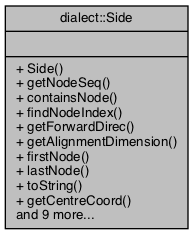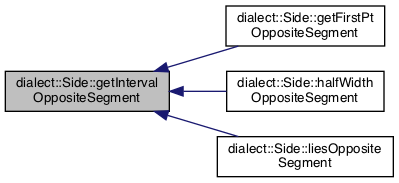A side of a Face. E.g. a rectangular Face has four Sides: north, south, east, and west. More...
#include <faces.h>

Public Member Functions | |
| Side (Nodes nodeSeq, CardinalDir direc) | |
| Standard constructor. More... | |
| Nodes | getNodeSeq (void) const |
| Get a copy of the node sequence. | |
| bool | containsNode (id_type id) const |
| Check whether this Side contains a Node of the given ID. | |
| size_t | findNodeIndex (id_type id) const |
| Get the index of a Node in this Side's node sequence. More... | |
| CardinalDir | getForwardDirec (void) const |
| Check the forward direction of this Side. | |
| vpsc::Dim | getAlignmentDimension (void) const |
| Check the dimension in which this Side is aligned. | |
| Node_SP | firstNode (void) const |
| Get a pointer to the first Node on this Side. | |
| Node_SP | lastNode (void) const |
| Get a pointer to the last Node on this Side. | |
| std::string | toString (void) const |
| Write a string representation. | |
| double | getCentreCoord (void) const |
| Check the centre coordinate of this Side. More... | |
| size_t | getNumRootNodes (void) const |
| Check how many of the Nodes on this Side are marked as root nodes. | |
| void | addTreePlacement (TreePlacement_SP tp) |
| Record a TreePlacement as having been placed on this Side. | |
| ProjSeq_SP | computeCollateralProjSeq (TreePlacement_SP tp, double padding=0) |
| Compute a projection sequence to remove/prevent overlaps between the given TreePlacement's tree box, and any existing tree boxes already on this Side, as well as ordinary perimeter nodes on this Side. More... | |
| interval | closedInterval (void) const |
| Compute the closed interval [a, b], where a and b are the extreme coordinates covered by this Side, up to the extremes of the boxes of the extreme Nodes. More... | |
| interval | getIntervalOppositeSegment (LineSegment &seg, bool openInterval=false) const |
| Compute the closed interval [a, b] that is the intersection of this Side's closed interval with that of a given Segment. More... | |
| bool | liesOppositeSegment (LineSegment &seg, bool openInterval=false) const |
| Check whether the closed interval spanned by this Side runs in the same dimension as a given line segment, and overlaps it in projection onto that dimension. More... | |
| Avoid::Point | getFirstPtOppositeSegment (LineSegment &seg) const |
| Compute the first point of the interval of this Side that lies opposite a given line segment. More... | |
| double | halfWidthOppositeSegment (LineSegment &seg) const |
| Given a LineSegment, find that portion of this Side that lies opposite it, (if any) and report the maximum half-width of the near half. More... | |
| const std::set< TreePlacement_SP > & | getTreePlacements (void) const |
| Read-only access to the set of TreePlacements that have been attached to this Side. | |
Detailed Description
Constructor & Destructor Documentation
◆ Side()
| Side::Side | ( | Nodes | nodeSeq, |
| CardinalDir | direc | ||
| ) |
Standard constructor.
- Parameters
-
[in] nodeSeq The Nodes belonging to this Side, in clockwise order w.r.t. the Face to which the Side belongs. [in] direc The cardinal direction in which we move as we go forward through the sequnce of Nodes.
- Note
- In theory the direc could be computed from the given nodeSeq; however, wherever possible we want to promote the setting of directions logically, based on existing constraints, rather than inferring directions geometrically. When Faces construct Sides, there is such a constrained direction in place.
Member Function Documentation
◆ closedInterval()
| interval Side::closedInterval | ( | void | ) | const |
Compute the closed interval [a, b], where a and b are the extreme coordinates covered by this Side, up to the extremes of the boxes of the extreme Nodes.
- Returns
- The closed interval covered by the Side.
References dialect::BoundingBox::getInterval().
Referenced by getIntervalOppositeSegment().


◆ computeCollateralProjSeq()
| ProjSeq_SP Side::computeCollateralProjSeq | ( | TreePlacement_SP | tp, |
| double | padding = 0 |
||
| ) |
Compute a projection sequence to remove/prevent overlaps between the given TreePlacement's tree box, and any existing tree boxes already on this Side, as well as ordinary perimeter nodes on this Side.
- Parameters
-
[in] tp The TreePlacement to be added to this Side. [in] padding Optional padding for the new tree box.
- Returns
- A ProjSeq representing the computed projection sequence.
References containsNode(), Avoid::Point::x, and Avoid::Point::y.

◆ findNodeIndex()
| size_t Side::findNodeIndex | ( | id_type | id | ) | const |
◆ getCentreCoord()
| double Side::getCentreCoord | ( | void | ) | const |
Check the centre coordinate of this Side.
- Note
- We are working under the assumption that all Nodes belonging to a given Side are centre-aligned!
References Avoid::Point::x, vpsc::XDIM, and Avoid::Point::y.
Referenced by getFirstPtOppositeSegment(), and halfWidthOppositeSegment().

◆ getFirstPtOppositeSegment()
| Avoid::Point Side::getFirstPtOppositeSegment | ( | LineSegment & | seg | ) | const |
Compute the first point of the interval of this Side that lies opposite a given line segment.
- Parameters
-
[in] seg The LineSegment in question.
- Returns
- The Point.
- Exceptions
-
Runtime error if this Side does not lie opposite the given segment.
- See also
- Side::liesOppositeSegment
References getCentreCoord(), getIntervalOppositeSegment(), and vpsc::XDIM.

◆ getIntervalOppositeSegment()
| interval Side::getIntervalOppositeSegment | ( | LineSegment & | seg, |
| bool | openInterval = false |
||
| ) | const |
Compute the closed interval [a, b] that is the intersection of this Side's closed interval with that of a given Segment.
- Parameters
-
[in] seg The LineSegment in question. [in] openInterval Set true if you want to instead intersect this Side's closed interval with the LineSegment's open interval.
- Returns
- An interval representing the intersection.
- Note
- Returns an empty interval (b < a) if the two intervals do not intersect, or if the Side and the LineSegment are not aligned in the same dimension.
References closedInterval().
Referenced by getFirstPtOppositeSegment(), halfWidthOppositeSegment(), and liesOppositeSegment().


◆ halfWidthOppositeSegment()
| double Side::halfWidthOppositeSegment | ( | LineSegment & | seg | ) | const |
Given a LineSegment, find that portion of this Side that lies opposite it, (if any) and report the maximum half-width of the near half.
- Parameters
-
[in] seg The LineSegment in question.
- Returns
- The desired half-width. Will be equal to -1 if the Side's interval does not intersect that of the segment, or if it does but the two are in-line with one another.
- Note
- The Edges of the Side are given the thickness value set for aligned edges in the underlying Graph.
References getCentreCoord(), dialect::Graph::getEdgeThickness(), and getIntervalOppositeSegment().

◆ liesOppositeSegment()
| bool Side::liesOppositeSegment | ( | LineSegment & | seg, |
| bool | openInterval = false |
||
| ) | const |
Check whether the closed interval spanned by this Side runs in the same dimension as a given line segment, and overlaps it in projection onto that dimension.
- Parameters
-
[in] seg The LineSegment in question. [in] openInterval Set true if you want to instead intersect this Side's closed interval with the LineSegment's open interval.
- Returns
- boolean
References getIntervalOppositeSegment().

The documentation for this class was generated from the following files:
- libdialect/faces.h
- libdialect/sides.cpp
 1.8.14
1.8.14